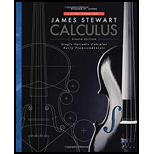
Study Guide for Stewart's Single Variable Calculus: Early Transcendentals, 8th
8th Edition
ISBN: 9781305279148
Author: Stewart, James, St. Andre, Richard
Publisher: Cengage Learning
expand_more
expand_more
format_list_bulleted
Question
Chapter 2.7, Problem 7PT
To determine
Whether the equation “
Expert Solution & Answer
Want to see the full answer?
Check out a sample textbook solution
Students have asked these similar questions
question 8
Find the area of the surface obtained by rotating the circle x² + y² = r² about the line y = r.
question 4 a and b
Chapter 2 Solutions
Study Guide for Stewart's Single Variable Calculus: Early Transcendentals, 8th
Ch. 2.1 - Prob. 1PTCh. 2.1 - Prob. 2PTCh. 2.1 - Prob. 3PTCh. 2.1 - True or False:
The slope of a tangent line may be...Ch. 2.2 - Prob. 1PTCh. 2.2 - Prob. 2PTCh. 2.2 - Prob. 3PTCh. 2.2 - Prob. 4PTCh. 2.2 - Prob. 5PTCh. 2.2 - Prob. 6PT
Ch. 2.2 - True or False: The graph in question 3 has a...Ch. 2.3 - Prob. 1PTCh. 2.3 - Prob. 2PTCh. 2.3 - Prob. 3PTCh. 2.3 - Prob. 4PTCh. 2.3 - Prob. 5PTCh. 2.3 - Prob. 6PTCh. 2.3 - Prob. 7PTCh. 2.4 - Prob. 1PTCh. 2.4 - Prob. 2PTCh. 2.4 - Prob. 3PTCh. 2.4 - Prob. 4PTCh. 2.5 - Sometimes, Always, or Never: If limxaf(x) and f(a)...Ch. 2.5 - Prob. 2PTCh. 2.5 - Prob. 3PTCh. 2.5 - Prob. 4PTCh. 2.5 - Prob. 5PTCh. 2.5 - Prob. 6PTCh. 2.6 - Prob. 1PTCh. 2.6 - Prob. 2PTCh. 2.6 - Prob. 3PTCh. 2.6 - Prob. 4PTCh. 2.6 - Prob. 5PTCh. 2.6 - Prob. 6PTCh. 2.6 - Prob. 7PTCh. 2.6 - Prob. 8PTCh. 2.6 - Prob. 9PTCh. 2.7 - Prob. 1PTCh. 2.7 - The slope of the tangent line to y = x3 at x = 2...Ch. 2.7 - Prob. 3PTCh. 2.7 - Prob. 4PTCh. 2.7 - Prob. 5PTCh. 2.7 - Prob. 6PTCh. 2.7 - Prob. 7PTCh. 2.7 - Prob. 8PTCh. 2.7 - Prob. 9PTCh. 2.7 - Which is the largest? a) f(a) b) f(b) c) f(c) d)...Ch. 2.8 - True or False: f(x) = tan x is differentiable at...Ch. 2.8 - Prob. 2PTCh. 2.8 - Prob. 3PTCh. 2.8 - Prob. 4PT
Knowledge Booster
Learn more about
Need a deep-dive on the concept behind this application? Look no further. Learn more about this topic, calculus and related others by exploring similar questions and additional content below.Similar questions
- f'(x)arrow_forwardA body of mass m at the top of a 100 m high tower is thrown vertically upward with an initial velocity of 10 m/s. Assume that the air resistance FD acting on the body is proportional to the velocity V, so that FD=kV. Taking g = 9.75 m/s2 and k/m = 5 s, determine: a) what height the body will reach at the top of the tower, b) how long it will take the body to touch the ground, and c) the velocity of the body when it touches the ground.arrow_forwardA chemical reaction involving the interaction of two substances A and B to form a new compound X is called a second order reaction. In such cases it is observed that the rate of reaction (or the rate at which the new compound is formed) is proportional to the product of the remaining amounts of the two original substances. If a molecule of A and a molecule of B combine to form a molecule of X (i.e., the reaction equation is A + B ⮕ X), then the differential equation describing this specific reaction can be expressed as: dx/dt = k(a-x)(b-x) where k is a positive constant, a and b are the initial concentrations of the reactants A and B, respectively, and x(t) is the concentration of the new compound at any time t. Assuming that no amount of compound X is present at the start, obtain a relationship for x(t). What happens when t ⮕∞?arrow_forwardConsider a body of mass m dropped from rest at t = 0. The body falls under the influence of gravity, and the air resistance FD opposing the motion is assumed to be proportional to the square of the velocity, so that FD = kV2. Call x the vertical distance and take the positive direction of the x-axis downward, with origin at the initial position of the body. Obtain relationships for the velocity and position of the body as a function of time t.arrow_forwardAssuming that the rate of change of the price P of a certain commodity is proportional to the difference between demand D and supply S at any time t, the differential equations describing the price fluctuations with respect to time can be expressed as: dP/dt = k(D - s) where k is the proportionality constant whose value depends on the specific commodity. Solve the above differential equation by expressing supply and demand as simply linear functions of price in the form S = aP - b and D = e - fParrow_forwardFind the area of the surface obtained by rotating the circle x² + y² = r² about the line y = r.arrow_forward1) Find the equation of the tangent line to the graph y=xe at the point (1, 1).arrow_forward3) Suppose that f is differentiable on [0, 5], and f'(x) ≤ 3 over this interval. If f(0) = −1, what is the maximum possible value of f(5)?arrow_forward2) Find the maximum value of f(x, y) = x - y on the circle x² + y² - 4x - 2y - 4 = 0.arrow_forwardarrow_back_iosSEE MORE QUESTIONSarrow_forward_ios
Recommended textbooks for you
- Algebra & Trigonometry with Analytic GeometryAlgebraISBN:9781133382119Author:SwokowskiPublisher:Cengage


Algebra & Trigonometry with Analytic Geometry
Algebra
ISBN:9781133382119
Author:Swokowski
Publisher:Cengage

03a: Numerical Differentiation Review; Author: Jaisohn Kim;https://www.youtube.com/watch?v=IMYsqbV4CEg;License: Standard YouTube License, CC-BY